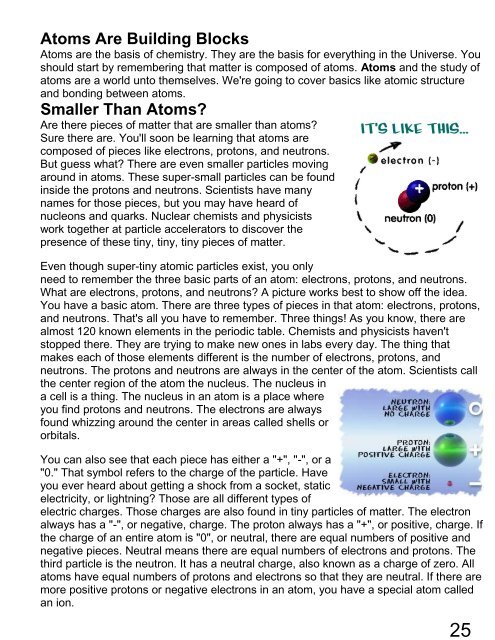You also want an ePaper? Increase the reach of your titles
YUMPU automatically turns print PDFs into web optimized ePapers that Google loves.
Atoms Are Building Blocks<br />
Atoms are the basis of chemistry. They are the basis for everything in the Universe. You<br />
should start by remembering that matter is composed of atoms. Atoms and the study of<br />
atoms are a world unto themselves. We're going to cover basics like atomic structure<br />
and bonding between atoms.<br />
Smaller Than Atoms?<br />
Are there pieces of matter that are smaller than atoms?<br />
Sure there are. You'll soon be learning that atoms are<br />
composed of pieces like electrons, protons, and neutrons.<br />
But guess what? There are even smaller particles moving<br />
around in atoms. These super-small particles can be found<br />
inside the protons and neutrons. Scientists have many<br />
names for those pieces, but you may have heard of<br />
nucleons and quarks. Nuclear chemists and physicists<br />
work together at particle accelerators to discover the<br />
presence of these tiny, tiny, tiny pieces of matter.<br />
Even though super-tiny atomic particles exist, you only<br />
need to remember the three basic parts of an atom: electrons, protons, and neutrons.<br />
What are electrons, protons, and neutrons? A picture works best to show off the idea.<br />
You have a basic atom. There are three types of pieces in that atom: electrons, protons,<br />
and neutrons. That's all you have to remember. Three things! As you know, there are<br />
almost 120 known elements in the periodic table. Chemists and physicists haven't<br />
stopped there. They are trying to make new ones in labs every day. The thing that<br />
makes each of those elements different is the number of electrons, protons, and<br />
neutrons. The protons and neutrons are always in the center of the atom. Scientists call<br />
the center region of the atom the nucleus. The nucleus in<br />
a cell is a thing. The nucleus in an atom is a place where<br />
you find protons and neutrons. The electrons are always<br />
found whizzing around the center in areas called shells or<br />
orbitals.<br />
You can also see that each piece has either a "+", "-", or a<br />
"0." That symbol refers to the charge of the particle. Have<br />
you ever heard about getting a shock from a socket, static<br />
electricity, or lightning? Those are all different types of<br />
electric charges. Those charges are also found in tiny particles of matter. The electron<br />
always has a "-", or negative, charge. The proton always has a "+", or positive, charge. If<br />
the charge of an entire atom is "0", or neutral, there are equal numbers of positive and<br />
negative pieces. Neutral means there are equal numbers of electrons and protons. The<br />
third particle is the neutron. It has a neutral charge, also known as a charge of zero. All<br />
atoms have equal numbers of protons and electrons so that they are neutral. If there are<br />
more positive protons or negative electrons in an atom, you have a special atom called<br />
an ion.


